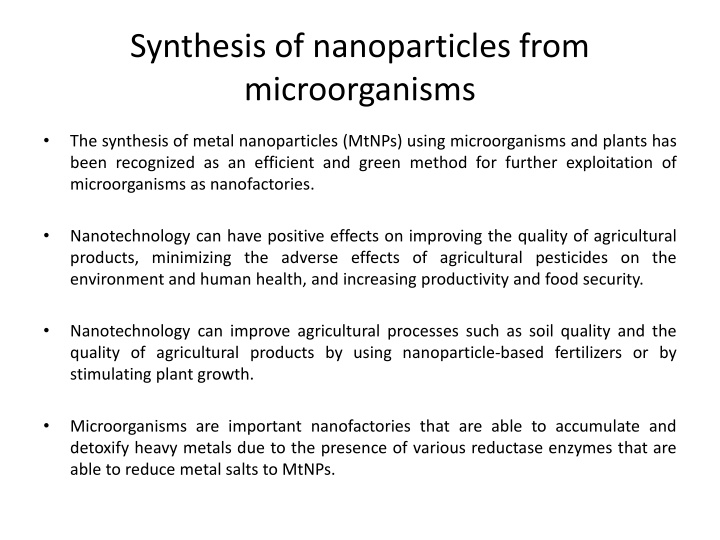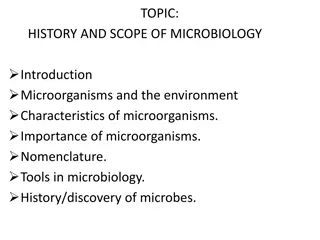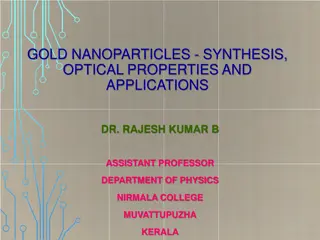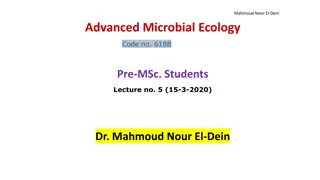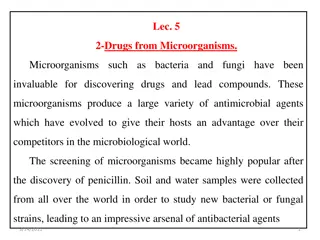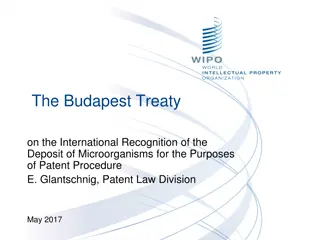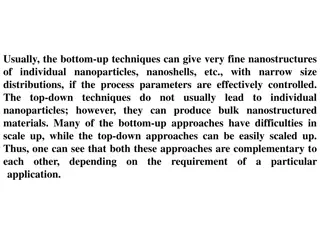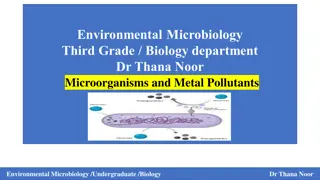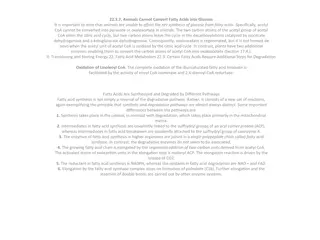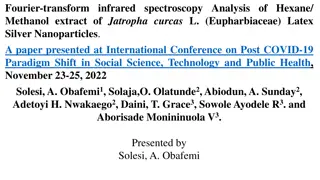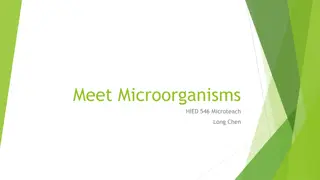Green Synthesis of Metal Nanoparticles Using Microorganisms
Synthesis of metal nanoparticles (MtNPs) via green methods involving microorganisms offers a sustainable approach with advantages such as cost-effectiveness, eco-friendliness, and high production yield. Microorganisms act as nanofactories through bio-mineralization processes that convert metal ions into MtNPs, showcasing potential benefits for agriculture and environmental remediation.
Download Presentation

Please find below an Image/Link to download the presentation.
The content on the website is provided AS IS for your information and personal use only. It may not be sold, licensed, or shared on other websites without obtaining consent from the author.If you encounter any issues during the download, it is possible that the publisher has removed the file from their server.
You are allowed to download the files provided on this website for personal or commercial use, subject to the condition that they are used lawfully. All files are the property of their respective owners.
The content on the website is provided AS IS for your information and personal use only. It may not be sold, licensed, or shared on other websites without obtaining consent from the author.
E N D
Presentation Transcript
Synthesis of nanoparticles from microorganisms The synthesis of metal nanoparticles (MtNPs) using microorganisms and plants has been recognized as an efficient and green method for further exploitation of microorganisms as nanofactories. Nanotechnology can have positive effects on improving the quality of agricultural products, minimizing the adverse effects of agricultural pesticides on the environment and human health, and increasing productivity and food security. Nanotechnology can improve agricultural processes such as soil quality and the quality of agricultural products by using nanoparticle-based fertilizers or by stimulating plant growth. Microorganisms are important nanofactories that are able to accumulate and detoxify heavy metals due to the presence of various reductase enzymes that are able to reduce metal salts to MtNPs.
The physical and chemical methods for MtNP synthesis have some disadvantages: the use of expensive equipment, high heat generation, high energy consumption and low production yield . The main drawback of these methods is the use of toxic chemicals, which present several environmental problems . This has generated a need for an environmentally friendly option for the synthesis of MtNPs, the current focus of which is the green synthesis of MtNPs from biological routes such as microorganisms, plants, microbial enzymes, polysaccharides and degradable
Advantages of green synthesis: They are simple, cost-effective, free of toxic and environmentally unfriendly chemicals, and as a result they have gained considerable importance in recent years Green synthesis mediated by microorganisms has acquired a special place due to their high growth rate, ease of cultivation and ability to grow in ambient conditions of temperature, pH and pressure. The biosynthetic mechanism of MtNPs in microorganisms can be carried out by trapping target metal ions from the surrounding environment and enzymatically converting them into elemental form, following a reduction mechanism. In general, microorganisms that live in metal-rich habitats are highly resistant to those metals due to their uptake and chelation of by intracellular and extracellular proteins. Consequently, this method, which mimics the natural bio-mineralization process, could be a favorable approach for the MtNPs synthesis
Figure shows a schematic illustration of intracellular and extracellular mechanisms of MtNPs biosynthesis. Intracellular biosynthesis involves unique transport systems in microorganisms in which the cell wall plays an important role due to its negative charge: positively charged metal ions are deposited in negatively charged cell walls through electrostatic interactions. After transport into the cells of the microorganism, ions are reduced using metabolic reactions mediated by enzymes such as nitrate reductase to forms MtNPs. The MtNPs accumulated in the periplasmic space can then be passed through the cell wall
NADH-dependent enzymes are responsible for the MtNP synthesis. The reduction mechanisms seem to begin by transferring an electron from NADH by NADH-dependent reductases as the electron carrier. Proteins secreted by microorganisms can act primarily as a stabilizing agent and provides colloidal stability while preventing agglomeration of MtNPs. For intracellular synthetic approaches microorganisms are cultured in a suitable growth medium with favorable pH and temperature conditions The biomass is harvested after an optimal incubation period and washed thoroughly with sterile water to minimize potentially undesirable effects of the culture medium. The resulting biomass is then incubated with metal salt solution.
An alternative is the use of cell-free (CF) approaches using either culture supernatant or cell-free extracts (CFE) In the CF approach biomass is centrifuged and the supernatant collected and incubated with an aqueous metal salt solution to synthesize the MtNPs. In this enzymes and other essential secretory components produced by the microorganism are used to synthesize the MtNPs and also to act as reducing and capping agents. In all cell free processes a color change in the reaction mixture is frequently the first indication of nanoparticle synthesis with the color change being dependent on the precise nature of the MtNP being produced. For example, a change in color from pale yellow to dark purple indicates the formation of gold nanoparticles, a pale yellow to deep brown color change indicates the formation of silver nanoparticles yellow to yellowish-white color change indicates the formation of manganese and zinc nanoparticles
Characterization of MtNPs synthesized from microorganisms is performed using various analytical techniques. UV visible spectroscopy is generally used to confirm the synthesis and stability of MtNPs. Fourier-transform infrared (FTIR) spectroscopy is used to measure the properties of MtNPs such as chemical concentration, surface chemistry, surface functional groups and atomic arrangement Transmission electron microscopy microscopy (SEM) and atomic force microscopy (AFM) can be used to visualize the position, size and morphology of MtNPs X-ray powder diffraction (XRD) is used to determine the crystallographic structure . The elemental composition of MtNPs is usually examine by energy dispersive x-ray spectroscopy (EDS) Dynamic light scattering (DLS) method is mainly used to evaluate the size as well as surface charge of MtNPs (TEM), scanning electron
